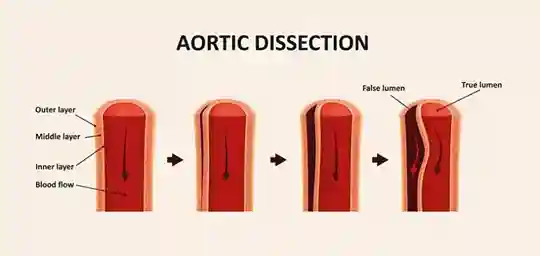Aortic dissection is a disorder that occurs when the inner layer of the aorta blood vessel tears and separates from the middle layer of the aorta wall. The symptoms are almost similar to heart disease and stroke.
Aortic dissection is a condition that is more common in men than women. The risk is higher in people aged 60 to 70 years. This disease can be fatal and cause death.
Although deadly, sufferers who receive early treatment have a higher chance of survival. Treatment steps are carried out by taking drugs and surgery.
These Are the Symptoms of Aortic Dissection
Aortic dissection is a condition caused by a weakening of the area in the aortic wall. Symptoms are differentiated based on the underlying type. There are two types, namely:
- Type A. This type is caused by a tear in the part of the aorta that comes out of the heart. Tears can also occur in the upper aorta ( ascending aorta ) which can extend into the abdomen.
- Type B. This type is caused by a tear in the lower aorta ( descending aorta ) that can extend into the abdomen.
Symptoms of type A and B aortic dissection are similar to other heart problems, such as a heart attack. Typical signs and symptoms include:
- Chest or upper back pain that gradually worsens. This condition is triggered by a tear that spreads to the neck or lower back.
- Sudden severe stomach ache.
- Loss of consciousness or fainting.
- Hard to breathe.
- Symptoms are similar to a stroke, such as visual disturbances, difficulty speaking, and paralysis on one side of the body.
- The pulse in one arm or thigh gradually weakens.
- Pain in the leg area.
- Difficulty walking.
Make an appointment with a hospital immediately if you experience the symptoms mentioned. Especially if the signs are accompanied by severe chest pain, sudden shortness of breath and symptoms of stroke.
Treatment Steps Depend on the Type
Aortic dissection is a medical emergency that requires immediate attention. Treatment may include surgery or medication, depending on the area of the aorta affected.
Type A Aortic Dissection
Treatment steps include:
- Surgery. This step aims to stop the blood flow from leaking into the aortic wall. The method is to reconstruct the aorta using a synthetic tube.
- Medications. These are designed to slow the heart rate and lower blood pressure, which can worsen aortic dissection. Medications are also given before surgery to control blood pressure.
Type B Aortic Dissection
Treatment steps include:
- Medications. Similar to type A, the medications given are aimed at reducing heart rate and lowering blood pressure which can worsen aortic dissection.
- Surgery . This step is done by removing the damaged part of the aorta and replacing it with a synthetic tube. If there is a leak in the heart valve, heart valve replacement surgery will also be performed.
After treatment, patients need to take certain medications for the rest of their lives to control their blood pressure. In addition, they also need to have regular CT or MRI scans to monitor their condition.

